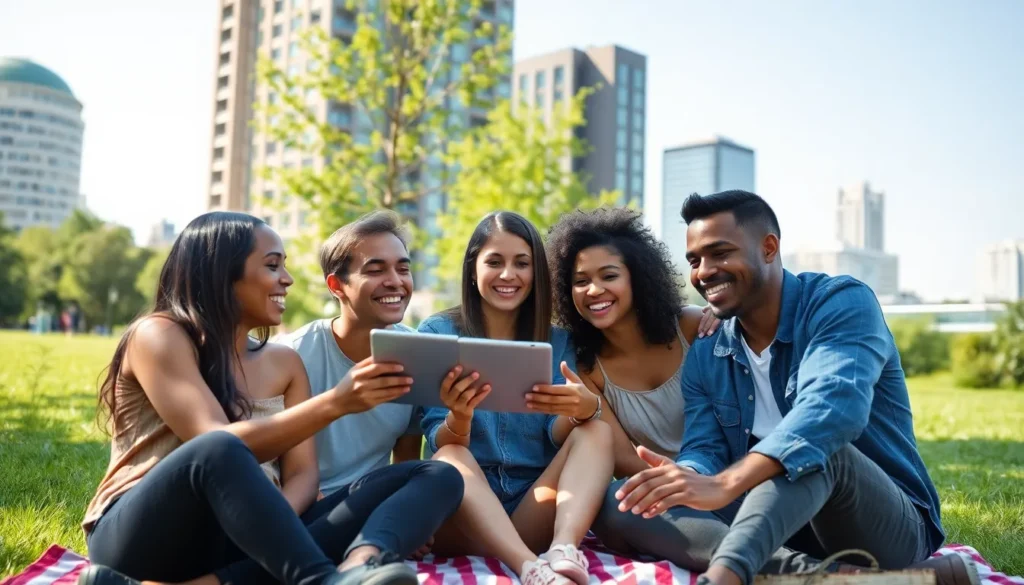Table of Contents
ToggleIn a world where swiping right can lead to love and emojis can express what words often fail to, technology has transformed the way people connect. Gone are the days of waiting for a friend to call; now, a simple text or a video chat can bridge distances faster than you can say “Wi-Fi.” It’s like having a social life on steroids, but without the questionable side effects.
Imagine planning a spontaneous gathering with friends across the globe while lounging on your couch in pajamas. With social media and apps at their fingertips, people can share experiences, celebrate milestones, and even argue over the best pizza toppings—all in real-time. This tech-enhanced social life isn’t just convenient; it’s revolutionizing how relationships thrive in the digital age. So, buckle up as we explore the delightful chaos of navigating friendships in a world where technology and social interaction collide.
Understanding Technology-Enhanced Social Life
Technology-enhanced social life refers to the integration of digital tools and platforms in personal interactions. It encompasses various forms of online communication that facilitate relationships across distances and time zones.
Definition and Scope
Technology-enhanced social life involves socializing through platforms such as social media, instant messaging, and video conferencing. Individuals connect and share experiences in real-time, regardless of geographic location. This phenomenon includes virtual events, online communities, and the use of apps that foster interaction. It expands the definition of friendship and social networks beyond physical boundaries, creating diverse forms of connectivity.
Importance in Modern Society
In modern society, technology-enhanced social life plays a crucial role in building and maintaining relationships. It allows people to stay in touch with family and friends effortlessly, fostering a sense of belonging. Social media platforms provide avenues for self-expression and community engagement. Furthermore, technology offers increased accessibility for individuals with mobility challenges or those living in remote areas, ensuring inclusivity in social interactions. Digital tools cultivate broader networks, facilitating professional connections and collaboration across industries.
Positive Impacts of Technology-Enhanced Social Life

Technology enhances communication by breaking down geographical barriers. Texts and video chats allow instant connections, making it easy to stay in touch with loved ones. These tools facilitate spontaneous interactions that strengthen relationships. Furthermore, digital channels support diverse forms of expression, enabling more meaningful conversations.
Social networks also expand significantly with technology. Individuals connect with people from various backgrounds, cultures, and interests. Online platforms allow shared experiences among friends, regardless of location. Communities form around hobbies, beliefs, and professional interests, fostering inclusivity. With technology, maintaining these expanded connections becomes seamless, leading to enriched social interactions and relationships.
Challenges of Technology-Enhanced Social Life
Technology-enhanced social life faces several significant challenges that impact human connections.
Social Isolation
Social isolation occurs despite increased digital connectivity. Many individuals experience a sense of loneliness, even when online interactions are frequent. These virtual conversations sometimes lack the depth of face-to-face interactions. The reliance on screens can reduce the motivation to engage in in-person gatherings, leading to feelings of disconnection. Research indicates that prolonged exposure to social media can heighten feelings of isolation. Individuals often compare themselves to others online, creating unrealistic expectations. This phenomenon contributes to diminished self-esteem and excessive reliance on virtual validation. As a result, social isolation can perpetuate a cycle where individuals withdraw further from real-world relationships.
Privacy Concerns
Privacy concerns represent another critical issue in a technology-enhanced social life. Social media platforms often collect extensive user data, leading to potential misuse or breaches. Users frequently share personal information without fully understanding the implications. This lack of awareness can lead to identity theft, cyberbullying, or harassment. Moreover, oversharing online can have long-term consequences, affecting both personal and professional lives. Data breaches have exposed millions of users’ sensitive information, reinforcing anxiety about privacy. Trust in digital communication channels wavers as individuals become increasingly aware of their vulnerability. Privacy concerns can significantly hinder open expression and honest interaction among friends and family members.
The Role of Social Media
Social media significantly impacts how individuals form and maintain their relationships. It offers numerous ways to connect, allowing friends and family to interact more frequently than ever.
Influence on Relationships
Social media strengthens relationships by bridging physical distances. It enables quick messages, photos, and videos, facilitating constant touch between people. Friends can share life moments instantly, creating a sense of presence despite being far apart. Users can find common interests through posts and comments, deepening their bonds. However, some interactions may lack emotional depth, leading to feelings of isolation even in busy online environments. Social media platforms provide tools for creating groups and communities, reinforcing shared connections. Regular engagement fosters familiarity, and many find comfort in seeing familiar faces online.
Community Building
Online communities thrive through social media, offering support and connection. Individuals can join groups based on hobbies, beliefs, or interests, allowing them to interact with like-minded peers. These platforms enhance collective identities, making it easy to meet others who share similar experiences. Users often discover resources and emotional support, cultivating a sense of belonging. Events and campaigns organized through social media unite individuals for causes, amplifying their voices. Community engagement transforms into collaborative initiatives, bringing people together for shared goals. This interconnectedness fosters stronger societal ties while breaking down traditional barriers.
Future Trends in Technology-Enhanced Social Life
Technology continues to evolve, shaping social interactions in new and exciting ways. Future advancements promise to enhance connectivity and engagement.
Emerging Technologies
Virtual reality (VR) is set to redefine social experiences. Users will engage in immersive environments, transforming how they interact during events and gatherings. Augmented reality (AR) will allow people to share live moments with contextual enhancements, bridging physical and digital worlds seamlessly. Artificial intelligence (AI) will personalize user experiences by suggesting connections based on interests and behaviors. Blockchain technology may improve privacy and data security, fostering trust in online interactions. Social platforms are likely to incorporate these technologies to create richer, more engaging environments for users.
Predictions for Social Interactions
Communication styles will become more dynamic and interactive. Video calls might evolve into multi-sensory experiences, incorporating haptic feedback and spatial audio for greater immersion. As digital personalities gain traction, users may interact with AI-generated avatars that represent them in online spaces. Interest-based groups will flourish, leading to niche communities and specialized social networks. Shifts in privacy policies will challenge platforms to prioritize user control over personal information. Social interaction will focus on depth rather than volume, fostering meaningful relationships in a tech-enhanced world.
Technology’s role in shaping social life is undeniable. It has transformed how relationships are formed and maintained, enabling connections that were once impossible. As society continues to embrace digital tools, the potential for deeper and more meaningful interactions grows.
Emerging technologies like VR and AR promise to further enrich these experiences, creating immersive environments that enhance communication. However, as individuals navigate this tech-enhanced landscape, attention to privacy and the quality of interactions remains crucial.
The future of social life will likely balance convenience with authenticity, fostering connections that not only span distances but also resonate on a personal level.




